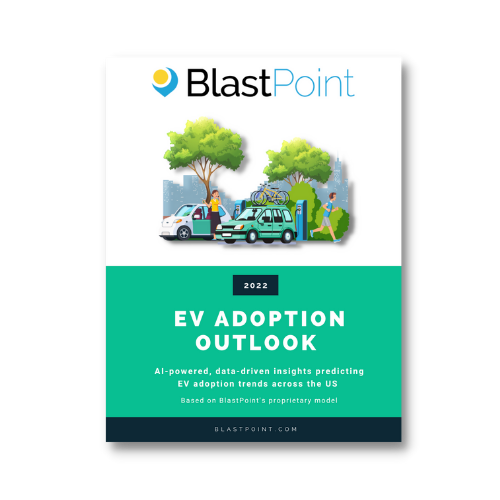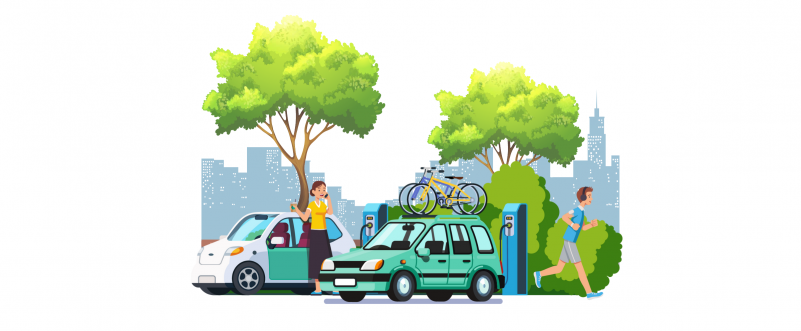Thanks to BlastPoint’s proprietary AI-powered algorithms, we’ve identified three key stages of EV readiness at the Census Tract level across the country. In our new report, the 2022 EV Adoption Outlook, we’ve predicted where consumers will be ready to adopt EV next so that utilities, automakers, and other key stakeholders in transportation electrification will be able to target them in 2022.
Keep reading for an overview of our key 2022 findings where we zoom-in on areas that are ready to adopt now throughout the US. Next, don’t miss out on the latest 2023 EV Adoption Outlook insights where BlastPoint’s EV demand models show where, across the country, consumers are on the leading edge of EV adoption – and also where intervention is needed for equity. Want to know more about adoption hotspots in your area? Get in touch.
Three Levels of EV Readiness in the US
2021 was a landmark year for transportation electrification in the US. EV sales through Q3 more than doubled from the first 3 quarters of 2020 to reach over one million vehicles. This is a huge increase over last year’s numbers despite the ongoing pandemic and major supply chain issues. In fact, it’s an even bigger increase than we anticipated in our 2021 EV Outlook. With the passage of President Biden’s Infrastructure Bill that provides $7.5b to create a nationwide network of EV charging stations, 2022 promises more exponential growth.
Where is most of that growth taking place?
Our algorithms have identified green, yellow, and red stages of EV readiness across the country based on key data attributes. Consumers in green segments are ready to adopt EV now, and many in fact already have. Consumers in yellow segments may be ready to adopt in the near future. However, consumers in red segments face significant roadblocks to adoption and won’t be ready or able to adopt EV for some time without interventions.

Zooming out and looking at the country as a whole, we see some regional patterns in EV adoption. Green segments are more evident on the coasts and near major cities. Much of the midwest is yellow, while red segments are dominant in the south.
Yet, while it’s true that the coasts are, overall, leading the pack when it comes to EV adoption, that doesn’t tell the whole story. A more accurate narrative explaining patterns in adoption across the country focuses on suburban, urban, and rural variations.
Current EV Hotspots: The Suburbs & Exurbs
It might seem surprising at first, since suburbs and exurbs usually aren’t considered hotbeds of innovation, but most EV growth has occurred and will continue occurring in these areas. The two major reasons for this are fairly simple: logistics and economics. Most EV charging takes place at private residences, and suburban homes are set up ideally for private EVSE installation. Many have garages and driveways with electrical access, making installing a charger very straightforward. The old adage “keeping up with the Joneses” also helps to explain the viral nature of EV growth in suburban areas: seeing an EV in a neighbor’s driveway makes EV more desirable.
While suburban areas are the fastest adopters on the residential front, a target area for growth will be commercial & public charging infrastructure. Suburbs often have a lower concentration of publicly available chargers, which limits charging to homeowners. Thanks to the rising cost of housing, more highly educated professionals are renting outside of urban areas. Increasing the number of publicly available chargers will ensure renters aren’t left behind.
Where will EV take off next?
Areas at the forefront of EV adoption, such as the San Francisco and New York City suburbs, will soon be reaching peak saturation. Based on our data, we’ve identified a second wave of EV adoption in other suburban and exurban areas across the US. These areas are, overall, more affordable than major metropolitan areas, but are close to colleges and universities and generally contain highly educated, middle-income Americans. Here are a few of the areas where data attributes indicate a coming adoption wave:
- Suburban Chicago
- Rochester, NY
- Kansas City, MO
- Lancaster, PA
- Manchester, NH
- Fort Lauderdale, FL
- Columbus, OH
Download the report to zoom in on these areas and others where consumers have a high propensity for EV adoption.
Promoting Equity in Urban and Rural Areas
Despite all of the progress, large swaths of the US map are red, meaning that consumers in these areas face serious roadblocks to transportation electrification. A majority of these areas are located in the South and the more remote regions of the Midwest. In particular, West Virginia, Alabama, Mississippi, and Arkansas stand out as having the highest concentrations of red segments in the country.

There are multiple barriers to transportation electrification in these largely rural areas with poverty rates above the national average. Money is at the top of the list: lower income and higher unemployment means that even used EVs are far out of price range for these consumers. Pair that with less concern about climate change and frequent long-distance drives across mountainous terrain, and it becomes clear why these areas won’t be ready to adopt anytime soon.
Expanding public charging infrastructure strategically and offering economic incentives beyond a relatively small refund will be crucial to removing roadblocks for individual consumers. Personalizing educational outreach and amplifying supportive community voices will be valuable tools. Additionally, since a higher percentage of consumers in red areas rent their homes, treating landlords like customers – even if they aren’t technically paying energy bills – can promote equity.
It should also be noted that many of these red areas contain interstate highways, and EVs from other states will be passing through. Partnerships between utilities, state and local governments, and the private sector – particularly gas stations and fast-food restaurants – offer a way forward.
To learn more about BlastPoint’s EV solutions, click here.
Download the 2022 EV Adoption Outlook



